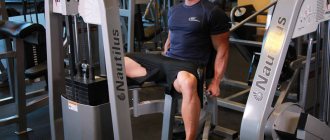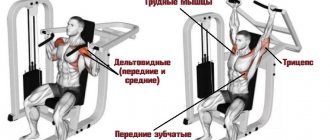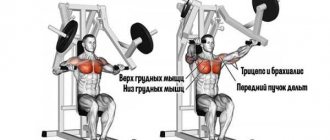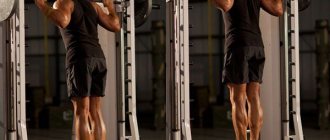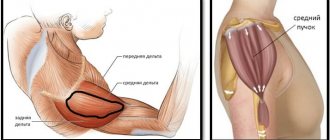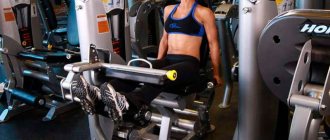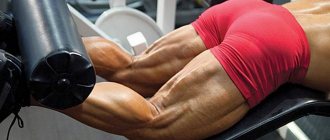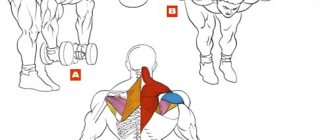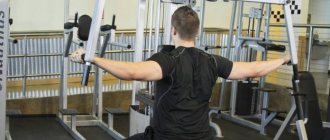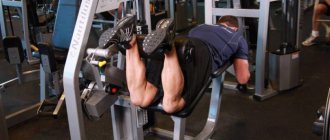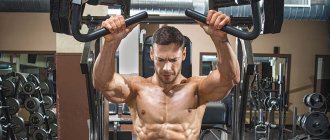Hip thrusts and extensions are given to beginners to strengthen the adductors, abductors and glutes. The abduction engages the adductors and strengthens the muscles so that the beginner is ready to perform squats. The simulator can be configured in such a way that the range of movement is accessible to anyone exercising. The exercise is undeservedly considered “feminine”. Meanwhile, it is also used in men's training, especially in cases where it is necessary to improve blood circulation to prevent prostatitis. The movement is performed after a short warm-up, usually after multi-joint exercises.
Execution technique
Initial position
- Unlike flyes, which can be performed standing, this exercise is always done from the starting position while sitting on the machine, with your back pressed against the back of the machine;
- If there is only a machine for mixing and spreading in the gym, you should rearrange the cushions of the exercise machine so that they face one another, and spread the “pedals” to the width available to you, and then secure them with clamps;
- After this, you need to place the pushing leg in the pedal of the simulator so that the bend of the knee joint touches the pillow, sit on the bench, and throw the other leg;
- Now it's enough to start bringing your legs together
Movement
- The back touches the back of the bench so that the position is stable;
- Due to the work of the adductor muscles of the thigh, the legs are brought together in front of them;
- Work continues until touching, in full amplitude;
- With exhalation, the legs return to their original position;
- The required number of repetitions is performed; it is better to leave the exercise machine while resting to avoid overstretching the muscles and ligaments.
Errors
- Push your hips with your hands;
- Fast low amplitude operation;
- Insufficiently complete mixing;
- Curvature of the back in the thoracic region;
- Too much deflection in the lumbar region;
- Shifting the pelvis forward along the exercise pad
Fitness. Leg abduction on the simulator.
Recommendations
- It is impossible to give universal advice regarding the backrest tilt of the exercise machine. Many people are unable to spread their legs wide enough if they lean their body slightly backward. The machines for this exercise have several backrest angles, so you just need to experiment and find yours;
- Sudden leg movements during exercise provoke overload of ligaments and joints. They can contribute to injury even at minimal weights. Should work smoothly;
- The exercise is not intended for “strength work”; the weight should be one that moves due to the work of the adductors. Many clients are confused by the presence of a large number of tiles in the simulator. So, if they exist, this does not mean that you need to use them all. Great “results” obtained through jerk work are fraught with sprains;
- The easiest way to fix the position of your back is by leaning your back on the back of the machine and squeezing your shoulder blades together;
- A reduced amplitude can only be used as a methodological technique for experienced athletes, or for those who are prevented by injury from working at full amplitude. If we are talking about a person who simply cannot spread his legs enough, he should think about the fact that the movement is more effective in full amplitude. The shortened version works after the main repetitions and approaches have been completed;
- The extreme point of concentric contraction here is the position with the knees together, and not the stretched position, as many people mistakenly think due to slight discomfort in the stretched muscles. Therefore, you need to linger with your knees together, not with your knees apart.
What muscles work
As a result of bringing the legs together in the simulator, only the adductor muscles of the femoral part of the legs are activated. The exercise is aimed at strengthening them. The human constitution is such that when walking, squatting and standing, the area between the legs is little used. Therefore, after cycling or jogging, it starts to hurt. By developing the adductor muscle, joint diseases can be prevented in the future.
The “leg abduction” simulator is aimed at tightening three muscles from among the adductors: shortened, elongated and large. The sartorius, gracilis, and pectineus muscles also work, as well as those located in the iliotibial tract.
The drive muscles are considered almost the largest in the leg area. It is a collection of muscle tissue that completely lies in the groin and thighs along the inner surface. It is problematic to feel it, since it is hidden under other muscles.
Bringing your legs together gives the following:
- strengthens the thighs from the inside;
- has a lifting effect on the adductor muscles;
- strengthens legs;
- gives more graceful outlines in the area of the “interpeduncle”;
- improves posture and gait;
- Reduces the risk of injury associated with muscle weakness.
Execution options
There are only two full variations:
- Crossover while lying on your back . The cables are fixed on the legs using cuffs, from the position the legs are brought together and spread to a comfortable depth. But unlike working in the simulator, the abs and soleus are involved a little more;
- Leg abduction while sitting with weights and feet placed on a slippery support . This option is sometimes practiced with the knees fixed with rubber shock absorbers and stretched in different directions. This option is intended for those who practice rehabilitation training.
The reduction in the simulator using a reduced amplitude is used after performing the main approach at full amplitude for the so-called finishing, but not as a full-fledged alternative to the exercise.
Leg abduction in the simulator
How to replace leg spreads
Training for girls in the gym can be done without spreading the legs. Often people are faced with the situation that the simulator is busy, and it is very difficult to wait for their turn on it. It is in such cases that athletes look for alternatives. Luckily, there are a couple of exercises that target the same muscle groups. These include:
- Steps with an elastic band. To do this you will need to get a special tape. Not all gyms have it, so many people have to buy it with their own money. But such a projectile has an advantage, because with it you can do full-fledged training at home, using different muscle groups. Steps with an elastic band are performed in this way: the band is attached to the ankles, the legs are slightly bent at the knees, after which one leg takes a step to the side, stretching it, and the other is pulled up so that the device does not fall to the floor. In this case, the back must be straight. You can try another option - do a squat at each step, reaching parallelism between your hips and the floor surface.
- Taking your leg to the side. A special simulator is also provided for this. This type of exercise works great on the outer thighs, buttocks, and even slightly improves stretching. To perform this, one leg is fixed in a special device on the simulator and moved to the side, lingering at the top point for two to three seconds.
Each of these exercises must be done in 2 sets of 15–20 repetitions. The load also needs to be gradually increased in order to progress, but you should not do this suddenly, as this increases the risk of injury.
Analysis of the exercise
Anatomy - what muscles work
Only the adductor muscle of the thigh works here. This movement is designed to strengthen it. We are designed in such a way that when walking, doing everyday squats and standing up, we use it minimally. Therefore, after skating, cycling, or running, many people experience pain in the adductor muscle. Its adequate development is the key to healthy knee and hip joints. Many people cannot even perform squats without weight without bringing their knees inward, “X”. This indicates both low mobility of the hip muscles and the fact that the adductors are not developed.
Often this movement is considered an “exercise for thin legs” and they try to do some wild amounts of repetitions in the exercise machine “burning out thick legs.” It doesn’t work like that, any movement simply strengthens the muscle, but does not “burn fat” or “make your legs thinner.” Yes, for a beginner woman, the volume of her hips may decrease due to the fact that the muscles become toned, but this does not make the movement a “weight loss exercise.”
For this reason, any variations on the theme of bringing your legs together in a slider as cardio, or performing a lot of exercises while lying on your back “to lose weight in your legs” do not make much sense.
Most of the load is taken on by the pectineus, longus, major and gracilis muscles of the thigh, which are commonly called “hip adductors”. The abdominal muscles are used for stabilization.
Preparing for the exercise
It is generally accepted that you need to statically stretch before this movement, since the effectiveness of the work depends precisely on the amplitude of the movement. In fact, those whose anatomical structure of the hip joint does not allow their legs to spread widely experience significant problems with amplitude.
Therefore, preparation for the exercise should include not so much static stretching, but joint warm-up with an emphasis on the hip joints. This exercise rarely comes first in leg training, so the main set of joint exercises is performed at the beginning of the workout, and not before the exercises.
In any case, 1 or even 2 approaches with light weight are needed to adapt to the range of motion and begin to perform the exercise efficiently.
Proper execution
- It is advisable to start controlling body position from the position of the back. The shoulder blades should not be directed towards the armpits, the trapezius should not rise;
- Then you should check the pelvis - both buttocks are pressed to the bench, you should not tear them off the working surface or change the angle, as if “leaning” on one side;
- The outer sides of the bends of the knee joints are pressed against the pads of the simulator;
- The heels rest completely on the supports, “hanging” only if the legs are rigidly fixed, but the design of the simulator does not allow standing on a full foot;
- It is important to work smoothly, exhaling slowly as you bring your legs together, and then return to the starting position;
- During training, this exercise should not take the place of the main one if the person is not injured, and should be performed in “cardio” mode for many repetitions in any case, since both of these options will not allow the athlete to recover sufficiently.
Errors
- Using the force of inertia;
- Jerks throughout the entire amplitude;
- Working too fast;
- Holding your breath;
- Raising the hips to the widest possible amplitude through pain;
- Any back movements during the exercise
Efficiency Tips
- Working out the hips will be of better quality if the movement is performed exclusively with the target muscles, and not due to inertia;
- The adduction workout can include sumo deadlifts or squats with the knees wide enough to engage the adductors in a multi-joint exercise format;
- The exercise should start with minimal weights, since for most people the adductor muscles do little work in everyday life and sports;
- If the goal is to correct technical errors in the squat, you should perform the exercise immediately after the squat, without waiting until the end of the workout
Contraindications
The leg muscle trainer is contraindicated:
- for lower back pain;
- for back injuries;
- for problems with the hip joint.
In case of these problems, starting the exercise is strictly prohibited. This is explained by the fact that if contraindications are not followed, there is a risk of worsening your situation and earning even more ailments, which will be much more difficult to cope with.
Inclusion in the program
This is a single-joint movement, even though we are sitting with our knees bent. For an uninjured person, it is included in the program after multi-joint leg work, such as squats or leg presses. You should be careful with the load, and do not use such a weight that the athlete cannot lift more than 10-12 times.
The exercise can be performed several times a week, and combined with a squat on each day if the goal is to strengthen the hip adductors to correct technical weaknesses in the squat.
